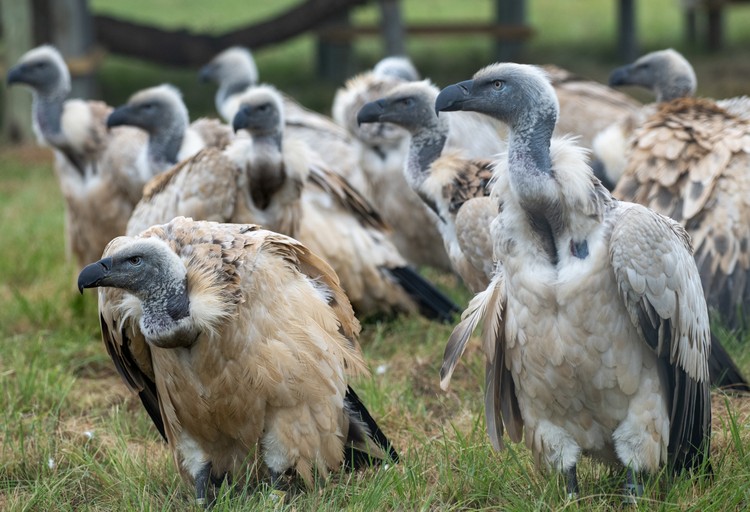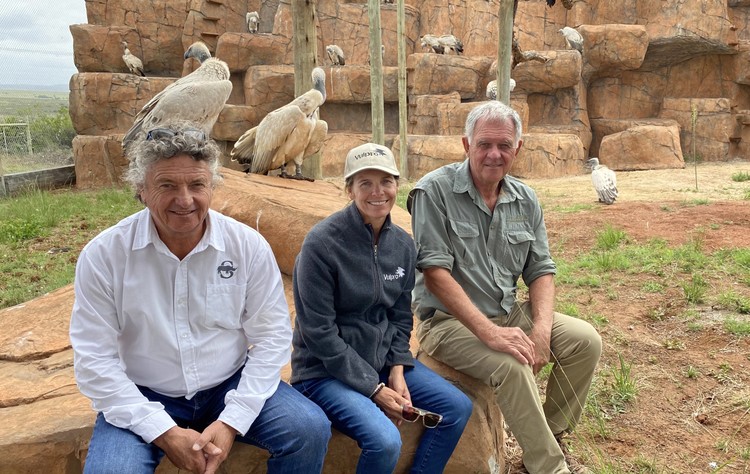Meticulous Eastern Cape effort to keep vultures from extinction
Vultures disabled by powerline collisions are taken care of and given a place to breed
A committee of Cape vultures explore their new surroundings soon after their arrival at Shamwari game reserve in the Eastern Cape. Photo: John Yeld
- Vulture numbers in Africa have plummeted so severely that every individual bird counts to reduce the risk of extinction.
- One of the biggest threats to the endangered birds is collisions with powerlines.
- A new facility has been opened in the Eastern Cape where these disabled vultures can still breed successfully.
It is hoped a new captive breeding facility at Shamwari game reserve in the Eastern Cape will help stem plummeting vulture numbers across southern Africa and prevent their imminent extinction.
Earlier this week, 163 majestic white-backed vultures and Cape vultures took an ardous 18-hour overnight journey from their previous home near Hartebeespoort in the North West Province, to a meticulously planned new captive breeding facility at Shamwari Private Game Reserve midway between Gqeberha and Makhanda.
Although the birds have the enviable ability of soaring effortlessly over thousands of kilometres across the entire sub-continent – none of these particular birds had the option of flying on this trip.
Most of them are maimed and disabled, and can either not fly at all or are unable to fly sufficiently well to survive in the wild. Some were still too young to fly.
Their new enclosures have been built to house these endangered birds that are at the heart of an effort to stem plummeting vulture numbers across the sub-continent.
So instead of flying, the vultures’ journey was undertaken in individual, colour-coded, and very carefully constructed and stacked designer crates.
Miraculously, not a single bird was lost en route in a move involving more than 50 people, constituting the largest vulture relocation operation ever undertaken.
Urgent task
The new captive breeding initiative is a joint venture between non-profit VulPro, the only organisation in Africa dedicated to vulture conservation and research, and Shamwari, one of the largest privately owned game reserves in the country and an Eastern Cape pioneer in the reintroduction of indigenous species that have been lost for various reasons.
VulPro will continue to operate its well-known vulture rehabilitation facility at Hartbeespoort, but all its captive breeding efforts will now be permanently located at Shamwari.
Despite being disabled, the birds in this breeding programme are still able to produce eggs and raise chicks, and these offspring will be released into the wild. The task is urgent: of the 16 vulture species in Africa, eight, including the white-backed vulture, are classified as “critically endangered” and three, including the Cape vulture, are “endangered. Only the griffon vulture and palm-nut vulture are not threatened. There are only 4,000 breeding pairs of the Cape vulture, southern Africa’s only endemic vulture, which has already gone extinct as a breeding species in Namibia, Swaziland, and Zimbabwe. Some other vulture species have declined by up to 97 percent over the past 30 years.
“We are facing an African vulture crisis,” Vulpro founder and chief executive Kerri Wolter told the small crowd who gathered at Shamwari to witness the successful arrival of the birds and the opening of the new facility. She said the threat of some African vultures going extinct in our lifetime was “very real”.
Major threats to vultures
Shamwari has carefully planned and constructed four large enclosures for the birds, each designed to meet the needs of the inhabitants. Two enclosures accommodate badly injured birds that require constant attention – the two species are kept separate to prevent interbreeding – while a third, adjacent to the reserve’s existing wildlife rehabilitation centre, includes an artificial cliff to provide optimal conditions for Cape vulture breeding pairs. The fourth is a pre-release enclosure built on high ground near the centre of the reserve, from where healthy young Cape vultures will be released. Further enclosures will be added over the next three years.
Wolter said most of the birds were disabled as a result of powerline collisions. Some had experienced such severe trauma that bones were sticking through their flesh and their wings had to be amputated. She said in these cases the choice to amputate rather than euthanise was because vultures are so endangered that “every single individual counts”.
Poisoning incidents, while not as frequent as power line collisions, could be catastrophic, she said. “One incident can wipe out an entire vulture colony. This is [currently] the biggest threat to vultures in Africa and on a global scale.”
She said the muti trade was also a threat. She believes poaching for this purpose will become the biggest threat to vultures in Africa.
One of the reasons for moving and expanding the facility to Shamwari was the growing risk of poaching at the Hartbeespoort Dam site. “In order to keep the birds safe, we needed a safe haven. Housing the largest captive population of African vultures in the world, it’s never a good thing to have all your eggs in one basket.
“With every single individual vulture that we can save, we make a difference. And by saving every single individual, we can save a population. This has been done very successfully in Europe, and in America with the Californian Condor, and I do believe this is the future of vultures in Africa.” Vulpro has already released 80 birds from its captive breeding programme into the wild.
From left, Shamwari general manager Joe Cloete, Vulpro founder and chief executive Kerri Wolter, and Shamwari veterinarian Dr Johan Joubert inside the new Cape Vulture breeding facility.
Bringing species back to the Eastern Cape
Shamwari general manager Joe Cloete said the initiative was a very important element in the conservation landscape of South Africa. “In our opinion, the relocation of 163 vultures back to the Eastern Cape is as important as the relocation of 163 rhinos, or 163 wild dogs,” said Cloete.
He said he had spent his childhood in the north-eastern Cape, near the rural village of Lady Grey. “In this area there’s the Karnmelkspruit River and on the cliffs in that massive gorge there was a very successful breeding population of Cape vultures. And more than 40 years ago, my brother and I started meeting farmers in that area to convince them to change their farming methods to do away with putting poisons out for vermin control. So when Johan [Shamwari vet Dr Johan Joubert] approached me just over a year ago with this new idea, I had no hesitation. On a personal note, it’s been a very special and emotional time for me.”
But it was also a very important for Shamwari, he added. “We’re all about conserving a vanishing way of life, bringing back all the species that used to occur in this area, and this is just another step in that continuing conservation journey. It’s a massive feather in our cap, we’re very proud to have these birds back here, and we thank the Vulpro board for putting their trust in us.”
Disclosure: John Yeld was a guest of Shamwari at the relocation event.
Support independent journalism
Donate using Payfast

Don't miss out on the latest news
We respect your privacy, and promise we won't spam you.
Next: Case of lawyer accused of race attack postponed
Previous: Dipuo Peters takes Parliament to court
© 2024 GroundUp. This article is licensed under a Creative Commons Attribution-NoDerivatives 4.0 International License.
You may republish this article, so long as you credit the authors and GroundUp, and do not change the text. Please include a link back to the original article.
We put an invisible pixel in the article so that we can count traffic to republishers. All analytics tools are solely on our servers. We do not give our logs to any third party. Logs are deleted after two weeks. We do not use any IP address identifying information except to count regional traffic. We are solely interested in counting hits, not tracking users. If you republish, please do not delete the invisible pixel.


